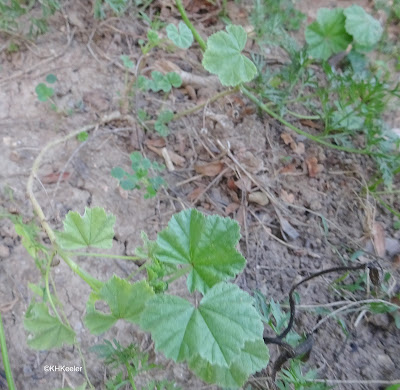You stop for a moment: what is that pretty white flower?
 |
| common mallow, Malva neglecta |
Then you look down and think, "oh just a weed."
True, common mallow is a plant from Europe, found on roadsides and invading gardens. It is not particularly aggressive, but can produce enough seeds to interfere with the grass of a young lawn. Once established, it can be hard to uproot, because it forms a big tap root deep into the soil. It doesn't make noxious weed lists, but it probably annoys numerous landowners.
 |
| common mallow in the lawn |
If you don't have too much if it, its a pretty plant. The leaves are big green circles, slightly ruffled, and reddish in the center and a little on the stems (petioles). The flowers are small and white, or white with pink rays, with the attractive flower structure of characteristic of hibiscus. It is in the hibiscus family, or rather, hibiscus is in common mallow's family, because the family, Malvaceae, a very big and important plant family worldwide, is named after common mallow's genus, Malva.
 |
| common mallow Malva neglecta flower |
Common mallow came to North America as a garden plant. The whole plant is edible. The leaves can be eaten raw in salads or cooked. The flowers make a nice garnish. The roots can be cooked and historically were one of the mallows boiled down to a sweet sticky mass, used as a merangue or to make marshmallows. (Europeans usually used a different species of mallow for marshmallows, Althea officialis.) Particularly popular are common mallow's dry fruits which are snacked on or used as a garnish. I find the leaves are unoffensive greens and the dry seed pods are tasty, crunchy like nuts. (As always, when tasting things, be sure of your identification. Mallows, the Malvaceae, are generally edible and this one doesn't look like much of anything else except a couple of other weedy, edible mallows such as Malva parviflora. See John Kallas, Edible Wild Plants for recipes for common mallow.)
 |
| common mallow seed pods |
Mallows, including common mallow, have a long history as medicinal plants, generally as a soothing treatment for the skin or stomach. German Commission E found common mallow effective for treatment of sore throats and dry coughs, gargled or drunk as tea.
 |
| common mallow with green and ripe fruits |
Malva is the traditional name for this plant, translated as mallow in English. The species epithet neglecta means about the same as it does in English, usually translated as "overlooked." You may hear it called buttonweed, cheeseweed, or cheese plant. These names are because the cute circular seed pods looked like buttons to modern Americans and miniature cheese wheels to Europeans. Mallows are called mauve in French. Malva neglecta is mauve négligée in French Canada. (See the Flora of North America if you think I made that up.)
 |
| common mallow, Malva neglecta, sprawling |
The Flora of North America calls common mallow "annual, biennial or perennial," so presumably it can live several years, but often doesn't. In many places, it is a winter annual: the seeds germinate in the fall, so that the new plants grow nice roots over the winter and can quickly flower in the spring. Their variation in life cycle makes them adaptable to climates all over the world.
Some websites call it a vine. It definitely sprawls, but I haven't seen it climb. Online dictionaries say tomato and potato plants are vines too, so think of it as viny like a tomato plant, not viny like a grape vine.
 |
| common mallow, Malva neglecta, with flower buds |
 |
| common mallow, Malva neglecta |
It is a pretty plant, an edible plant, and although widespread, rarely a problem weed. Don't overlook it.
Comments and corrections welcome.
References
Common Mallow,
Malva neglecta. 2018. Invasive Plant Atlas.
link (Accessed 8/30/23).
European Medines Agency. 2018. Assessment report on
Malva sylvestris L. and/or
Malva neglecta Wallr., folium and
Malva sylvestris L., flos Final.
link (Accessed 8/31/23)
Hill, S.R. 2020.
Malva neglecta Wallroth.
Flora of North America.
link (Accessed 8/30/23).
Kallas, J. 2010. Edible Wild Plants. Gibbs Smith, Layton Utah.
Kathy Keeler, A Wandering Botanist








No comments:
Post a Comment